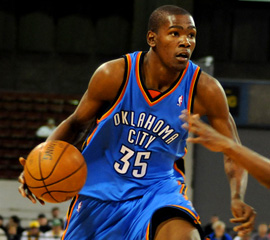

In this post we will discuss Fantasy Basketball projections for the 2013-14 season.
As I discussed in my last post about Fantasy Baseball ranking based off of the 2014 Steamer projections, I love rankings based off of quantitative analysis. Rankings that take a statistical approach to value ascription lack the histrionic overtones and biases that are present throughout most of the fantasy fodder online, and they provide market inefficiencies that owners can take advantage of when drafting.
While there are very few quantitative NBA projection systems, compared to the amount of MLB projection systems, there are two that I found. Perhaps the most well known, Kevin Pelton’s SCHOENE projection system is available to ESPN Insiders, and I succumbed to the forces of the evil empire and subscribed to a 30 day free trial to procure the necessary information to write this article. Alas, ESPN Insider does not provide SCHOENE projections in an exportable format: BOOO!
The second NBA Projection system that is widely available is the Basketball Reference Simple Projection System (SPS). The SPS takes into consideration playing time, aging curves, and the last three years of player performance. Most importantly, the SPS has been proven to be accurate in its projections, and slightly more effective than the SCHOENE projection system.
I took the SPS projections, translated them into fantasy value for a standard eight category rotisserie league—points, rebounds, assists, steals, blocks, three pointers, field goal percentage, and free throw percentage—and then weighted those projections with the total amount of minutes ESPN projects that player to play; the SPS weights all stats on a Per-36 minute performance rate, and you get weird results when you don’t take into consideration the amount of playing time a player will realistically be on the court. For example, Manu Ginobili projects to as a top twenty player when you don’t take into consideration the brief amount of minutes he plays.
Here are the results of the Simple Projections System (Note these rankings do not have positional adjustments weighted into their projections, so all the centers need to get a huge boost):
[table id=9 /]
The top of the projections are filled with the usual sorts that populate the majority of fantasy basketball pundits’ rankings. What’s interesting is how high Kobe Bryant and Russell Westbrook are ranked, but this can be explained by the outrageous amount of time ESPN projects Westbrook and Bryant to play—71 and 56 games respectively. What’s even more interesting is how much higher Kevin Durant is ranked than the rest of the field—free throw percentage is the forgotten but crucial category.
Experts have projected Patrick Beverley, Anthony Davis, Eric Bledsoe, and Demarcus Cousins to break out this year, but not to this extent. This is where I find that quantitative analysis is most helpful when projecting players. Before this last baseball season, I performed a similar exercise where I aggregated a large group of MLB projection systems—Marcel, FANS, Steamer, Oliver—and translated their results into fantasy value. The projections produced many valuable insights, but the most shocking was when it projected Paul Goldschmidt as a top fantasy player; Goldschmidt finished fifth overall. When projecting, experts often miss the value of a good but not great season by a player at a young age (i.e. Goldschmidt’s 2012 season). Projection systems don’t miss this, and they recognize what a player’s performance relative to their age actually means.
Andre Igoudala, Josh Smith, Pau Gasol, and Blake Griffin are several players that SPS thinks you should stay away from, at least compared to where other people in the industry have them ranked. People forget how poor this group of players is at shooting free throws, but when it comes to rotisserie Fantasy Basketball, free throws are an eight of the game.
It is important to keep a good prospective when looking at these rankings, or any rankings for that matter. Ask yourself, “Why is this player ranked here?” And depending on the reason you come up with, don’t decide whether or not you agree with the ranking, but decide whether or not you agree with the logic of that ranking. The logic is more important than the perception.
Devon Jordan is obsessed with statistical analysis, non-fiction literature, and electronic music. If you enjoyed reading him, follow him on Twitter @devinjjordan.
We listed out the top-10 baseball cards from 1958 Topps Baseball, which is a historic…
One of the most iconic baseball cards of the ‘90s is the 1993 Upper Deck…
We created these tips for new card collectors hoping to save them both time and…
The man who dares surpass The Great One! Buying Alexander Ovechkin cards is one way…
Collecting the 13 best 2024 NBA rookie cards can help improve your basketball card collection,…
Whether you are new to collecting hockey cards or not, knowing the best Young Guns…
This website uses cookies.
View Comments
uhh you forgot derrick rose.